Minter Dial's Blog: Minter Dialogue, page 69
November 22, 2017
10 Reasons Why Every CEO Needs To Be More Digital….And Have A Strong Digital Presence
“Why should I bother being on social networks?” asked the CEO of a major organization. “It seems like a major waste of my time when I barely have enough time for strategic thinking.”
As the social media landscape continues to evolve, it’s only right that top executives question the validity of any of the social media platforms. Yet, I remain adamant that top executives should be digital and on social media, so that they can better answer the above question themselves. I even believe that being digital can facilitate and expedite some of the tasks and decisions that formerly (pre-digital) were much harder and more time-consuming to do.
Digital Presence – Strategy First
At a CEO breakfast I animated recently in Moscow, I presented the top 10 reasons (see below) I believe top executives need to be more digital. Essentially, any argument to use digital at that level ought to be linked to strategy. In fact, CEOs who are using digital to great effect can and should only be properly judged when their activity is tied into their strategic intent. For example, if a company is battling to find the best and most digital talent, then it is most likely a good idea for the CEO (and C-Suite) to have a well-endowed LinkedIn profile. Here are a couple of examples of CEOs/Chairmans who have been using digital with good intent and success:
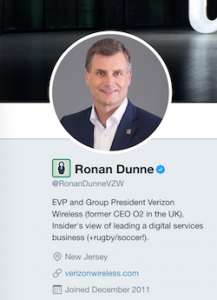 Ronan Dunne, President Verizon Mobile wants to make sure that he stays in touch with his customer base. As a result, much like when he was head of O2 UK, he has a developed a strong presence on Twitter that enables him, every morning, “to stroll the store floor to listen directly to the customers’ comments.” He now has 32K followers and is following 802.
Ronan Dunne, President Verizon Mobile wants to make sure that he stays in touch with his customer base. As a result, much like when he was head of O2 UK, he has a developed a strong presence on Twitter that enables him, every morning, “to stroll the store floor to listen directly to the customers’ comments.” He now has 32K followers and is following 802.Noel Prioux, now Executive Director for Carrefour Latin America (Brazil and Argentina), was CEO of Carrefour France and was faced with a challenge of changing his company culture and, parenthetically, building Carrefour’s social media presence. With a passion for photography, he created his own Instagram account and developed a following of over 9K followers, far above what the Carrefour France account managed at that time. It worked. The Carrefour marketing team was mobilized to develop its social media presence.
Bill Marriott, Chairman of Marriott, wanted to communicate about the brand not just to customers, but to the entire Marriott company staff. Despite being well on years, Bill Marriott wanted to show his personality and that he could remain relevant. He created the Marriott on the Move blog in January 2007, on which he continues to publish posts about twice per month. Through the social channels, Marriott now has over 330K fans for the corporate Facebook page, over 436K followers on Twitter and a blog that (recently) ranked #1522 on Alexa worldwide. Moreover, very quickly they were able to attach additional revenue gains thanks to the blog.
In each case above, the individual in question is not afraid to present a more personal side to his professional profile. For Ronan Dunne, he talks rugby. For Noel Prioux, he shows his esthetic taste (in black & white only!). and for Bill Marriott, he gives his personal observations. Underpinning the success and longevity of their initiatives, it’s critical to be able to mix the personal with the professional to show a more genuine and authentic self.
The top 10 reasons to build a digital presence
 Most CEOs suffer from the eternal problem of not having enough time. They often wish they had more time for strategic planning. So, the idea of spending precious time on building a digital presence (i.e. on social media) is often viewed with great skepticism. Without doubt, every CEO needs to evaluate and master how they wish to spend their time. Yet, I believe that developing and building a digital presence can help with certain strategic needs, not least of which is getting closer to one’s employees and customers. Here is a list of the top 10 reasons I believe that CEOs ought to consider in evaluating why and how they can do so themselves.
Most CEOs suffer from the eternal problem of not having enough time. They often wish they had more time for strategic planning. So, the idea of spending precious time on building a digital presence (i.e. on social media) is often viewed with great skepticism. Without doubt, every CEO needs to evaluate and master how they wish to spend their time. Yet, I believe that developing and building a digital presence can help with certain strategic needs, not least of which is getting closer to one’s employees and customers. Here is a list of the top 10 reasons I believe that CEOs ought to consider in evaluating why and how they can do so themselves.
Even if you’re not planning to be active, at the very least you need to establish your intended identity to keep your name clear and hold it (for example, when you are ready to populate it with the content).
It’s how you are researched by prospective recruits and clients, so you need to have a solid presence to show who you are.
To listen directly to and interact with your customer. First, it’s important to figure out where your customers are hanging out.
To understand better the Customer Experience (CX) for better design decisions. N.B. Your competitors may not be providing the best CX benchmark.
To set the example for the rest of your company. Help show how your employees can help support and amplify your brand.
To communicate more effectively with all your stakeholders on the different channels they prefer to use. After all, communication is the lifeblood of any organization.
To be more efficient with the tools and platforms for internal functioning. When used well, these digital tools can save enormous amounts of time and energy.
To stay up to date with the new technologies best suited to your strategy.
To enjoy learning – have fun (and stay young at heart).
To protect your name when an issue arises. You can’t protect against a crisis once it’s blown up. You need to create a well-installed presence, replete with social proof on well trafficked sites to make sure that any poor publicity is drowned out by the previously, well-constructed online presence.
If that weren’t enough, being digital and active on social media could also help you understand what your competitors are up to! Getting help to get started is crucial. However, I firmly believe that the good effects come from when the CEO manages his/her presence alone!
What do you think? Rebuttals and comments welcome!
The post 10 Reasons Why Every CEO Needs To Be More Digital….And Have A Strong Digital Presence appeared first on Myndset.
November 19, 2017
Creating meaningful experiences and events with Julian Hay (MDE257)
 Julian Hay is founder and CEO of iMedia Group, which covers iMedia, iMediaSport as well as some other interesting initiatives including The Wondr Academy and Wondrlust. Julian has embedded in everything he does his WHY. It’s a purpose led organisation, helping companies to create experiences that transcend marketing solutions. In this interview, we talk about the sponsorship industry, what goes into a meaningful experience and how create value for the business.
Julian Hay is founder and CEO of iMedia Group, which covers iMedia, iMediaSport as well as some other interesting initiatives including The Wondr Academy and Wondrlust. Julian has embedded in everything he does his WHY. It’s a purpose led organisation, helping companies to create experiences that transcend marketing solutions. In this interview, we talk about the sponsorship industry, what goes into a meaningful experience and how create value for the business.
Below, you’ll find the show notes and, of course, you are invited to comment. If you liked the podcast, please take a moment to go over to iTunes to rate the podcast.
To connect with Julian Hay:
Find Julian Hay on Linkedin
Sites mentioned by Julian Hay:
Professor Martin Seligman – Pursuit of Happiness
Man’s Search for Meaning (on Amazon) by Viktor Frankel
Simon Sinek – Start With Why
If you know how to reach Jonathan Haidt, please contact me!
————–
Further resources for the Minter Dialogue Radio Show:

Meanwhile, you can find my other interviews on the Minter Dialogue Radio Show in this podcast tab, on Buzzsprout or via iTunes. Please don’t be shy about rating this podcast on iTunes here!
Music credit: The jingle at the beginning of the show is courtesy of my friend, Pierre Journel, author of the Guitar Channel. And, the new sign off music is “Finger Paint,” written and performed by Josh Saxe, produced by Chase Geiser. Here’s a link on iTunes. I invite you to take a spin on Pierre’s podcast or listen to more of Josh’s music!
The post Creating meaningful experiences and events with Julian Hay (MDE257) appeared first on Myndset.
November 14, 2017
Is Progress Inevitable? The More Digital One Is, The Less Digital One Wants To Be?
I’ve been known to start off conversations by saying: The more digital you become, the less digital you will want to be. #DigitalIQ Most Gen Y don’t agree with me; Gen Z typically frown at the thought; and Baby Boomers tend to split down the middle. The underlying concept behind this question is: Is digital bound to deliver progress?
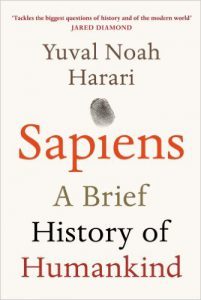 In the best-selling book, Sapiens, author Yuval Noah Harari definitely puts a rather gloomy note on how we have “evolved” and/or are “evolving” as human beings, and about our ongoing obsession with progress. In each phase along the way where Homo Sapiens has made breakthroughs, Harari calls to task the so-called “progress” and highlights the mitigated results, especially as it concerns our general level of happiness. It makes for a hugely important read given today’s world of fast-paced change, innovation and “progress.” In the wake of reading Sapiens, I have come across a number of other articles that seem to point in the same direction: What if technology were not actually bringing about progress?
In the best-selling book, Sapiens, author Yuval Noah Harari definitely puts a rather gloomy note on how we have “evolved” and/or are “evolving” as human beings, and about our ongoing obsession with progress. In each phase along the way where Homo Sapiens has made breakthroughs, Harari calls to task the so-called “progress” and highlights the mitigated results, especially as it concerns our general level of happiness. It makes for a hugely important read given today’s world of fast-paced change, innovation and “progress.” In the wake of reading Sapiens, I have come across a number of other articles that seem to point in the same direction: What if technology were not actually bringing about progress?
Taming the digital beast
The other day I was listening to a Freakonomics podcast, How to Launch a Behavior-Change Revolution, that discussed with Harvard Economics professor, David Laibson, how he approached the “evil” of laptops in the classroom. The presence of digital devices in the classroom is a veritable beast for professors and fellow students alike. In a novel approach, Laibson imposed an opt in approach, whereby students were as ked if they preferred to bring their laptops into the classroom. The others were to opt out (by default, if no response provided). Those who opted to bring their laptops were then isolated in a specific area of the classroom, to avoid the constant distractions and disruptions (notifications, messages, Facebook feed, keyboard typing…) that they bring to those around them. About 80% of students opted out and the results at the end of the year showed a high overall positive rating for their facility to learn. It sort of reminded me of the days of the smoking section, back when trains and airplanes actually allowed smoking onboard. Even the smokers preferred to sit in the non-smoking compartment. I can’t help but believe the laptop users would actually prefer to sit in the laptop-free area as well…
ked if they preferred to bring their laptops into the classroom. The others were to opt out (by default, if no response provided). Those who opted to bring their laptops were then isolated in a specific area of the classroom, to avoid the constant distractions and disruptions (notifications, messages, Facebook feed, keyboard typing…) that they bring to those around them. About 80% of students opted out and the results at the end of the year showed a high overall positive rating for their facility to learn. It sort of reminded me of the days of the smoking section, back when trains and airplanes actually allowed smoking onboard. Even the smokers preferred to sit in the non-smoking compartment. I can’t help but believe the laptop users would actually prefer to sit in the laptop-free area as well…
Device-free kids
 Never two without three, as the French saying goes, a friend of mine posted on Facebook this article from The Independent, Bill Gates and Steve Jobs raised their kids tech-free — and it should’ve been a red flag. The article spoke about the noxious effects of all these tools and devices on kids and family life. It states that both Steve Jobs and Bill Gates strictly limited use by their own kids of the very devices they helped create, because they implicitly knew of their malevolent effects.
Never two without three, as the French saying goes, a friend of mine posted on Facebook this article from The Independent, Bill Gates and Steve Jobs raised their kids tech-free — and it should’ve been a red flag. The article spoke about the noxious effects of all these tools and devices on kids and family life. It states that both Steve Jobs and Bill Gates strictly limited use by their own kids of the very devices they helped create, because they implicitly knew of their malevolent effects.
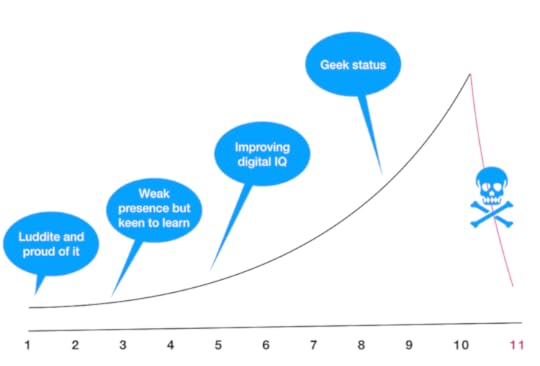
One to Eleven Digital IQ (with a wink to Spinal Tap). The higher your score, the more you use digital tools and platforms with ease. Comes a point, though, when some swear off it…
The more you know, the more you don’t want to know?
Sean Parker, co-founder of Facebook, dazzled the airwaves in a recent interview in Philadelphia, saying “I don’t know if I really understood the consequences of what I was saying [or doing], because [of] the unintended consequences of a network when it grows to a billion or 2 billion people and … it literally changes your relationship with society, with each other … It probably interferes with productivity in weird ways. God only knows what it’s doing to our children’s brains.” (See Axios article). Enough to pause and think, eh?
Moreover, the data on youths — those most involved on digital — shows rising suicide rates in the UK, Sweden and USA… And the picture isn’t necessarily better for adults (see this Guardian article in UK). Of course, digital is not entirely to blame; but one could legitimately conclude that societal progress hasn’t improved our mental wellbeing.
Technology makes us a slave to progress?
In all of the stories above, there seems to be a common thread, questioning the notion of progress. Is technological progress bound to be an improvement? What if progress were in fact the root of all evil? For example, as fast as we are devising new and exciting ways to use artificial intelligence, harvest insights from banks of big data, invent new cures thanks to advancements in genomics, craft humanitarian rescues with drones, or create currencies with negligible costs and unfettered by state control and manipulation, there is a reverse side of the coin. Deviant individuals are unscrupulously working on using AI, big data, cyber currencies and drones — even genomics I am sure — with decidedly evil intent. And, if you listen to Harari, it seems that each revolution — cognitive, farming, scientific, industrial, information and biotechnological — has brought around unexpected consequences, the nature of which have not been, on balance, as beneficial as typically imagined when compared with the initial forager homo sapiens, some 70,000 years ago.
I take these disparate conversations, articles and book as a sign of how there may yet be a broader trend away from technology and a gradual realization that technology is not actually improving our world… enough. In which case, I continue to believe strongly in the need for greater meaningfulness.
Your thoughts and reactions are welcome!
The post Is Progress Inevitable? The More Digital One Is, The Less Digital One Wants To Be? appeared first on Myndset.
November 12, 2017
Innovate or Disappear. Olivier Laborde on leadership and innovation within large business (MDE256)
 Olivier Laborde is one of those unusual breeds of operational executives in a large well-known multinational who has also published a book, an award winner no less, Innovate or Disappear (in French, Innover ou Disparaître, published by Dunod May 2017). I was fortunate to be a co-panelist with Olivier in Paris at an event hosted by Violaine Champetier at OnePoint (see the featured image above). Based on his experience of running the Innovation Lab at Natixis and the insights from his book, Olivier talks about the challenges and key success factors of driving change and innovation within a large business.
Olivier Laborde is one of those unusual breeds of operational executives in a large well-known multinational who has also published a book, an award winner no less, Innovate or Disappear (in French, Innover ou Disparaître, published by Dunod May 2017). I was fortunate to be a co-panelist with Olivier in Paris at an event hosted by Violaine Champetier at OnePoint (see the featured image above). Based on his experience of running the Innovation Lab at Natixis and the insights from his book, Olivier talks about the challenges and key success factors of driving change and innovation within a large business.
Below, you’ll find the show notes and, of course, you are invited to comment. If you liked the podcast, please take a moment to go over to iTunes to rate the podcast.
To connect with Olivier Laborde:
You can find Olivier on Twitter: @labordeolivier
Olivier Laborde on Linkedin
————–
Further resources for the Minter Dialogue Radio Show:

Meanwhile, you can find my other interviews on the Minter Dialogue Radio Show in this podcast tab, on Buzzsprout or via iTunes. Please don’t be shy about rating this podcast on iTunes here!
Music credit: The jingle at the beginning of the show is courtesy of my friend, Pierre Journel, author of the Guitar Channel. And, the new sign off music is “Finger Paint,” written and performed by Josh Saxe, produced by Chase Geiser. Here’s a link on iTunes. I invite you to take a spin on Pierre’s podcast or listen to more of Josh’s music!
The post Innovate or Disappear. Olivier Laborde on leadership and innovation within large business (MDE256) appeared first on Myndset.
November 7, 2017
The Future of Blogging Is Dynamic and Filled With AI – But It Will Be Hard Work
I recently spoke on a panel, invited by Bernie J Mitchell, about the future of blogging, with marvelous co-panelists Katie King and Lucy Hall, and moderated by Andy Bargery. The questions and flow of the conversation led to several key conclusions. First, blogging is far dead, although there is plenty of blogger fatigue. Secondly, it’s absolutely vital to be strategic about one’s blogging, especially if you want to make a living out of it. Thirdly, the killer app will be artificial intelligence. Finally, get out of your comfort zone and keep learning about the new tools and platforms.
Meanwhile, here is the story I chose to wind about the future of blogging, as I would project it out a few years.
Please meet JJ — a future blogger
Getting up at 5:45am thanks to the sleep band that knows to wake her after the REM cycle is completed, JJ did her morning yoga session beside her bemused dogs. At 6:15am, she sat down in her pod and explored the latest news and overnight messages. At 6:30am, armed with a fresh cup of vitajava, the dashboard gave her some inputs for the morning’s writing. Using a combination of facial mood recognition, the analysed energy in her fingers as she typed on the keyboard as well as her biometric data, the empathic intelligence (EI) assistance provided a series of floating images and words of inspiration. JJ then made a selection of 3 short phrases and clicked on an image. This set was then uploaded into the ABM (auto blog machine).

JJ jumped up for a quick refill of her java. By the time she had come back, the ABM’s 600-word text had been created and automatically sent out to the TaskRabbiters, a distributed network of helpers whose role was to read, correct, annotate and reference. The premium service provided multiple titles and well thought-through tagging that took into account Google trends and long-tail searches.
The mixture of human & machine
The net result was a text that was the optimal combination of machine learning, EI and human input. At the beginning, JJ used to watch with fascination as the text was modified in front of her eyes by numerous helping hands. It was rather magical. Now just past 7am, JJ sipped her vitajava concoction as she put on some finishing touches to the text.
The challenge of distribution
Once approved, she committed the text to the new and improved Wibbitz (AI-powered automated media production) that was able to convert texts into multiple media formats, including the standard 5-, 12-, 45- and 90-second videos for Snapchat, Instagram, Facebook, and Youtube accounts respectively; an image with a caption and hashtags for Instagram; another image, text and link for Pinterest; and, of course, the audio version (with accompanying text) for the podcast version, automatically narrated. 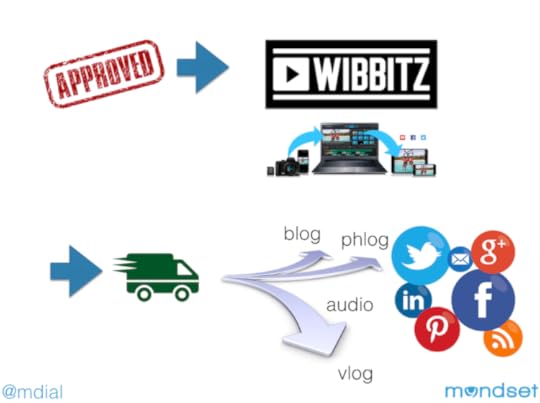
With the complete set of media formats, the different versions were sent out in a customized and tailored manner to the various platforms. The data continued to show that the vlog format was the big winner in terms of views, but the audio listeners were a hardcore group of loyal fans and the engagement in the phlog and regular blog remained stable, after having tapered off quite a lot from the heyday period back in the early 10’s.
Customized delivery times
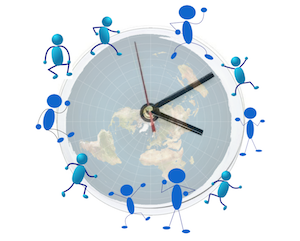 JJ sat back and watched the numbers take off. The automated A/B testing on the titles would come back within 15 minutes and then the volume and velocity of distribution would start to hit the airwaves. Increasingly, delivery times were determined by the opt-in feature for each platform (i.e. each recipient could choose when they received the posts). For JJ, most of her fans were keen to start off their day with her vital information. Yet, since her readers were worldwide, distribution was complete only by the end of the afternoon.
JJ sat back and watched the numbers take off. The automated A/B testing on the titles would come back within 15 minutes and then the volume and velocity of distribution would start to hit the airwaves. Increasingly, delivery times were determined by the opt-in feature for each platform (i.e. each recipient could choose when they received the posts). For JJ, most of her fans were keen to start off their day with her vital information. Yet, since her readers were worldwide, distribution was complete only by the end of the afternoon.
Outstanding questions for the future of blogging
With the arrival of new technologies and with new usages of existing tech, there are a number of key questions that any serious bloggers will need to face:
Will bloggers be prepared to pay to play? As Hubspot CEO, Brian Halligan, announced recently, content creation is now a pay-to-play game if one is serious about building a customer database and solid distribution.
 How will voice search and audio change the way text should be written and tagged?
How will voice search and audio change the way text should be written and tagged?To what extent will bloggers need to develop a strong ethical line with all the emerging technologies and the pressure on performance?
How will bloggers refine their business models and improve monetization?
Conclusion
There’s a lot of blogger fatigue out there, although there is also a general level of fatigue as everyone is trying to stay up with the new tools and options, managing the always-on time pressures as well as the evermore difficult and elusive results. Yet, the opportunities for clever blogging, aided by smarter technologies looks very encouraging. It will require a good deal of adaptability and a renewed conviction in order to make one’s blogging effective. AI will surely be a key technology, but big data, the sharing economy, internet of things and empathic intelligence will also be instrumental in the future of blogging.
The post The Future of Blogging Is Dynamic and Filled With AI – But It Will Be Hard Work appeared first on Myndset.
November 5, 2017
Converting From a Commercial to a Social Enterprise, A Real Life Case with Phillip Ullmann at Cordant Group (MDE255)
 Phillip Ullmann is the Chief Energiser (CEO) of Cordant Group, a £850MM family-owned international company offering integrated services including recruitment, security, cleaning and technical electrical services. In this interview, we discuss how Phillip has led the company from a commercial company to a social enterprise, bringing along his co-shareholders, board of directors, managers and the entire workforce. He’s on a mission to encourage broader uptake of social enterprise as a sustainable model. A fascinating journey.
Phillip Ullmann is the Chief Energiser (CEO) of Cordant Group, a £850MM family-owned international company offering integrated services including recruitment, security, cleaning and technical electrical services. In this interview, we discuss how Phillip has led the company from a commercial company to a social enterprise, bringing along his co-shareholders, board of directors, managers and the entire workforce. He’s on a mission to encourage broader uptake of social enterprise as a sustainable model. A fascinating journey.
“Power is like water. If you share power, it’s like sharing water in a cup. Everyone has less water. Influence is like fire. If you #influence others, each flame ignites another flame.” @CordantPeople
Below, you’ll find the show notes and, of course, you are invited to comment. If you liked the podcast, please take a moment to go over to iTunes to rate the podcast.
To connect with Phillip Ullmann:
You can send an email directly to Phillip Ullmann here
Phillip Ullmann on Linkedin
Sites mentioned in the interview:
Reinventing Organizations by Frederic Laloux
————–
Further resources for the Minter Dialogue Radio Show:

Meanwhile, you can find my other interviews on the Minter Dialogue Radio Show in this podcast tab, on Buzzsprout or via iTunes. Please don’t be shy about rating this podcast on iTunes here!
Music credit: The jingle at the beginning of the show is courtesy of my friend, Pierre Journel, author of the Guitar Channel. And, the new sign off music is “Finger Paint,” written and performed by Josh Saxe, produced by Chase Geiser. Here’s a link on iTunes. I invite you to take a spin on Pierre’s podcast or listen to more of Josh’s music!
The post Converting From a Commercial to a Social Enterprise, A Real Life Case with Phillip Ullmann at Cordant Group (MDE255) appeared first on Myndset.
October 31, 2017
Digital Museum Experience in Cluj, Romania – Interactive Cultural Experiment

Virtual Reality experience of the Dacian incursions
I should have known that Cluj, the second largest city in Romania, was going to provide a few digital surprises. And it didn’t fail me. First off, the entrepreneurial driver from the airport immediately volunteered to tether Internet access through his own mobile data — without my even thinking about it. That was most kind and a first for any taxi driver I’ve ever taken. Secondly, it’s clear Cluj — and Romania in general — have great high-speed Internet access. Because of the famous technological leapfrog, their 4G and fiber infrastructure make it a top ten connected country in the world, in a league with countries like South Korea, Scandinavia and Hong Kong. (See DoTheTest) Meanwhile, both UK and US peak internet speeds lag woefully behind. Thirdly, Cluj has 40,000 people working in IT out of a population of just 330,000 (in other words, a huge proportion of the available workforce).
At the same time, Romania is also home to the world’s hub of online stealth, most notably out of the leafy town of Râmnicu Vâlcea, nicknamed “Hackerville.” While attending the TeComm Conference 2017, where I keynoted on how to Futureproof eCommerce sites, I skipped out to make a cultural visit and was entirely surprised by the digital experience at the National Museum of Transylvanian History.
Crafting A Digital Museum Experience
If the topic and the content of the museum is about old artefacts and the long history of Transylvania, the overall size of the museum was truly magnified by the multiple digital experiences that were inserted throughout. I counted 6 different digital experiences.
QR Codes
 While QR codes are generally considered a marginal technology, they were broadly present at the museum, including within the displays. Getting a read on them was a bit awkward, especially when they were down by your feet… It might have been optimal to have them available at chest level, affixed on the outside of the case?
While QR codes are generally considered a marginal technology, they were broadly present at the museum, including within the displays. Getting a read on them was a bit awkward, especially when they were down by your feet… It might have been optimal to have them available at chest level, affixed on the outside of the case?
It was, all the same, quite the statement of modernity mixed in with antiquity.
Motion Detection Interaction (eg Kinect)
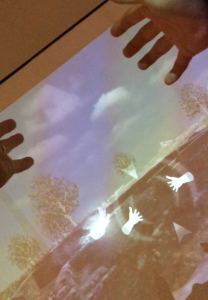 There were two variations of motion detection interactions. The first was on a rather large scale (entire wall) and it was an immersive experience that involved a gamified treasure hunt. You essentially have to go find three objects among the ruins, and after you pick them up, you get to hear about the artefact in hand. I tried to film the experience, but the motion detection required both hands and you had to turn the body in order to instruct the software. As a result, my film efforts were rather unsuccessful. If you’d like to see it, you can check out the film I’ve uploaded onto YouTube here. What I can say is that my efforts gathered quite a crowd that happened to walk in in the middle of my journey. I’m not sure if it was stage fright or the fact that I hadn’t taken of my coat and hat, but by the end of the 3+ minutes, I was actually sweating. Quite unexpected. As for a better understanding of the objects I found, I was barely able to focus on what the machine was telling me.
There were two variations of motion detection interactions. The first was on a rather large scale (entire wall) and it was an immersive experience that involved a gamified treasure hunt. You essentially have to go find three objects among the ruins, and after you pick them up, you get to hear about the artefact in hand. I tried to film the experience, but the motion detection required both hands and you had to turn the body in order to instruct the software. As a result, my film efforts were rather unsuccessful. If you’d like to see it, you can check out the film I’ve uploaded onto YouTube here. What I can say is that my efforts gathered quite a crowd that happened to walk in in the middle of my journey. I’m not sure if it was stage fright or the fact that I hadn’t taken of my coat and hat, but by the end of the 3+ minutes, I was actually sweating. Quite unexpected. As for a better understanding of the objects I found, I was barely able to focus on what the machine was telling me.
The second motion detection experience one was far less complex, involving using your hands to pick one object out of a line of objects on either side of the screen and then to use your hands to inspect via a 360 degree inspection. I snapped a quick picture of a lady, clearly intent on figuring out how it worked as much as (more than?) learning about the object “in hand.” I noted that this lady had her tongue sticking out, a signal of her concerted effort I believe!
Touchscreen Jigsaw Puzzle
 I found a group of three women working together to complete a digital jigsaw puzzle for a ruins site. I didn’t check to see if there were other games on offer on this terminal, but the group component of this was what struck me. Not sure if they learned anything though. For digital native kids, meanwhile, it seemed rather primitive. Given the height of the terminal, the kids most likely to consider this as novel might not be able to reach as high.
I found a group of three women working together to complete a digital jigsaw puzzle for a ruins site. I didn’t check to see if there were other games on offer on this terminal, but the group component of this was what struck me. Not sure if they learned anything though. For digital native kids, meanwhile, it seemed rather primitive. Given the height of the terminal, the kids most likely to consider this as novel might not be able to reach as high.
The Virtual Reality Experience
 I’ve probably done over 50 VR experiences by now, so my level of exigency is certainly different from a neophyte. I watched someone go through it first, then I took on the mantle. I donned the VR helmet and a controller on each hand. On top of the controller you have a button to leap forward. Underneath, you have the ability to move your virtual fingers in order to grip. Throughout, the patient man in charge knelt down below to make sure I didn’t trip on the wire and gave the occasional guidance. You have a few objects to find within the site (a Dacian building) and you can pick them and place on small ledges or pedestals.
I’ve probably done over 50 VR experiences by now, so my level of exigency is certainly different from a neophyte. I watched someone go through it first, then I took on the mantle. I donned the VR helmet and a controller on each hand. On top of the controller you have a button to leap forward. Underneath, you have the ability to move your virtual fingers in order to grip. Throughout, the patient man in charge knelt down below to make sure I didn’t trip on the wire and gave the occasional guidance. You have a few objects to find within the site (a Dacian building) and you can pick them and place on small ledges or pedestals.
To be clear, it’s a very first degree experience. For sure, it’s immersive, but the storyline is decidedly empty. Moreover, very quickly you bump into the outer extremities of the environment. Overall, the educational component is quite entirely lost on you without any earphones.
The Dead Terminal
 As with any digital experience, there are often bugs. In a corner, my trained eye found a terminal that was defunct, clearly the victim of a malfunction. I’m not sure what it held, but I suspect some kind of point, drag and drop discovery game. Who knows? What one does know is that for any digital experience, one should always expect bugs and create contingency plans. I’ve seen this again and again in retail digital experiences.
As with any digital experience, there are often bugs. In a corner, my trained eye found a terminal that was defunct, clearly the victim of a malfunction. I’m not sure what it held, but I suspect some kind of point, drag and drop discovery game. Who knows? What one does know is that for any digital experience, one should always expect bugs and create contingency plans. I’ve seen this again and again in retail digital experiences.
In Conclusion: Digital Museum Experience More Than Education
Overall, for a museum, I have to say that the experience was entirely novel. I was delighted by the efforts, and, if nothing else, had the chance to interact with numerous other strangers at the museum. Yes, as you can imagine, I would score the different games as pure gimmick. However, if they are able to leverage some social / media attention around it, maybe they can increase their traffic? And, at 6 lei (1.50E) for the entrance fee, I can say that I got much more for my money than I had bargained for.
The post Digital Museum Experience in Cluj, Romania – Interactive Cultural Experiment appeared first on Myndset.
October 29, 2017
Brand Relevancy, Disruption and Digital Transformation with Charlene Li (MDE254)
 Charlene Li is author, thought-leader and world renowned speaker, principal analyst of Altimeter, a Prophet Company. In this podcast, we explore the ongoing disruptive challenges of digital transformation. We also take a closer look at the latest research coming out of Prophet, The 2017 Brand Relevance Index, discussing the importance of content, purpose and the different cultural aspects by country.
Charlene Li is author, thought-leader and world renowned speaker, principal analyst of Altimeter, a Prophet Company. In this podcast, we explore the ongoing disruptive challenges of digital transformation. We also take a closer look at the latest research coming out of Prophet, The 2017 Brand Relevance Index, discussing the importance of content, purpose and the different cultural aspects by country.
Below, you’ll find the show notes and, of course, you are invited to comment. If you liked the podcast, please take a moment to go over to iTunes to rate the podcast.
Check out @ProphetBrand’s Brand Relevance Index https://www.prophet.com/relevantbrand... #ProphetBRI
To connect with Charlene Li:
You can send an email to Charlene Li here
You can find Charlene on Twitter: @CharleneLi
Find Charlene Li’s book on Amazon
Charlene’s eponymous site
Sites mentioned:
The 2017 State of Digital Transformation, research led by Brian Solis at Altimeter
————–
Further resources for the Minter Dialogue Radio Show:

Meanwhile, you can find my other interviews on the Minter Dialogue Radio Show in this podcast tab, on Buzzsprout or via iTunes. Please don’t be shy about rating this podcast on iTunes here!
Music credit: The jingle at the beginning of the show is courtesy of my friend, Pierre Journel, author of the Guitar Channel. And, the new sign off music is “Finger Paint,” written and performed by Josh Saxe, produced by Chase Geiser. Here’s a link on iTunes. I invite you to take a spin on Pierre’s podcast or listen to more of Josh’s music!
The post Brand Relevancy, Disruption and Digital Transformation with Charlene Li (MDE254) appeared first on Myndset.
October 26, 2017
The WIFI User Experience – An Easy Way To Start Improving Your Customer’s Journey
I think you’d agree that access to the Internet has become second nature these days. When you check in at the hotel, receptionists know to indicate the wifi login even before telling where the gym or lifts are located or when breakfast is served. When a friend comes to stay with you, you will as readily send the wifi code along with instructions for entering the premises. In cities around the world, wifi is becoming available on the street, and is almost de rigueur at airports, in stores and cafés. In ‘normal’ offices, guests now typically have some specific log in options. So, we are all becoming increasingly familiar with, if not demanding about the wifi connection. Yet, some networks are much easier and friendlier than others to get onto. Whether because of technical limitations, security fears, cost or ignorance, some organizations see fit to make logging in something of a titanic struggle. And, I’m not even talking about the other problem of speed of connection.
Wifi – a harbinger of customer experience
I have no statistical evidence to base this on, but I have to believe there is a relationship between the wifi experience and the customer experience (CX) abilities of the company. My supposition is that the more convenient you make it for your customer, the more likely you have the right mindset to create a good customer experience.
Here are some ways that you can get access to wifi:
Click on the open network (without need to log in). The device then auto-connects thereafter whenever the network is detected. (e.g. at a hotel out in the boondocks). NB Some open networks require a re-confirmation/opt in (despite using the same device).
Select the network, then log in once (in the browser or popup) with varying degrees of personal data. The device then auto-connects thereafter. (e.g. password protected access at home). NB Some companies will use this to capture a client’s details. Will the subscriptions be opt in or opt out?
Select the network and log in. Then you need to confirm the pre-saved log in every time you visit (eg. at Heathrow).
Log in with limited long-term duration (e.g. for the duration of your hotel reservation).
Log in with new credentials each day (e.g. some security conscious corporations). NB In this option, companies love to provide long strings of complicated and painful codes to type in on the small iPhone screen…

October 22, 2017
Building Blocks And Social Media Communities With LEGO – James Poulter (MDE253)
 James Poulter is the Senior Social Media Manager at LEGO, working on strategy and innovation for the beloved group. In this interview, we discuss the LEGO mission, how that plays out in the social media strategy, what are some of the keen and key insights in using the SM effectively as well as some of exciting innovative ideas that LEGO is working on.
James Poulter is the Senior Social Media Manager at LEGO, working on strategy and innovation for the beloved group. In this interview, we discuss the LEGO mission, how that plays out in the social media strategy, what are some of the keen and key insights in using the SM effectively as well as some of exciting innovative ideas that LEGO is working on.
Below, you’ll find the show notes and, of course, you are invited to comment. If you liked the podcast, please take a moment to go over to iTunes to rate the podcast.
To connect with James Poulter:
You can find James on Twitter: @jamespoulter
James Poulter on Linkedin
Sites mentioned:
Death Star skit with Eddie Izzard
LEGO Life
LEGO Serious Play
————–
Further resources for the Minter Dialogue Radio Show:

Meanwhile, you can find my other interviews on the Minter Dialogue Radio Show on Buzzsprout or via iTunes. Please don’t be shy about rating this podcast on iTunes here!
Music credit: The jingle at the beginning of the show is courtesy of my friend, Pierre Journel, author of the Guitar Channel. And, the new sign off music is “Finger Paint,” written and performed by Josh Saxe, produced by Chase Geiser. Here’s a link on iTunes. I invite you to take a spin on Pierre’s podcast or listen to more of Josh’s music!
The post Building Blocks And Social Media Communities With LEGO – James Poulter (MDE253) appeared first on Myndset.
Minter Dialogue
- Minter Dial's profile
- 14 followers



